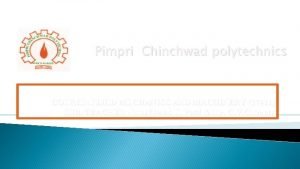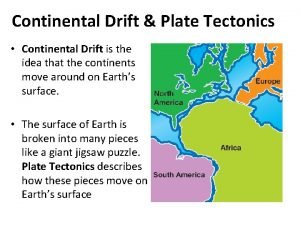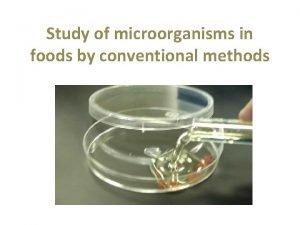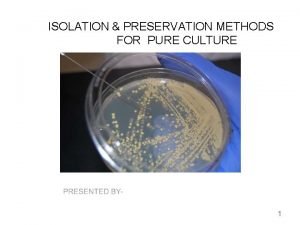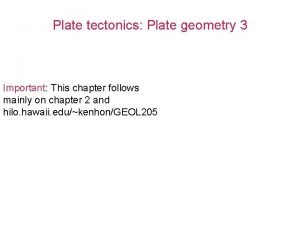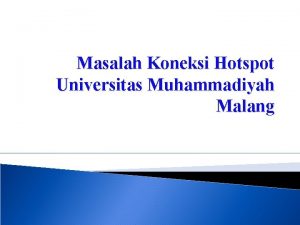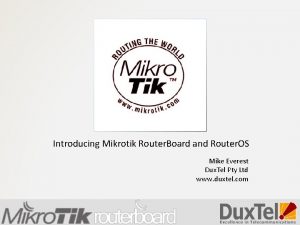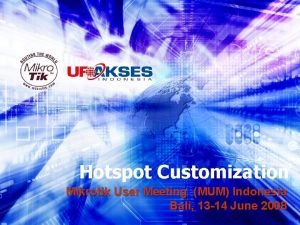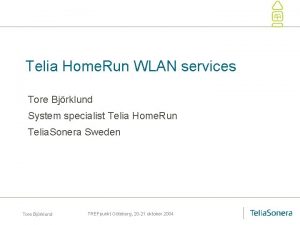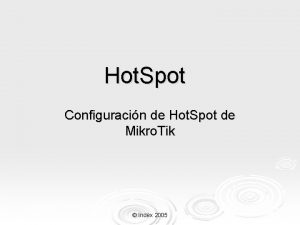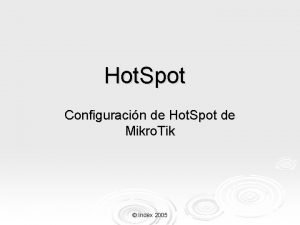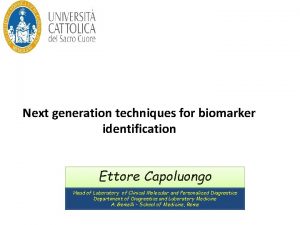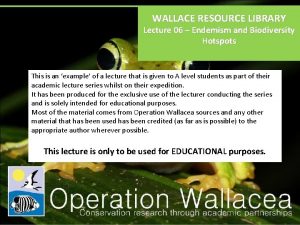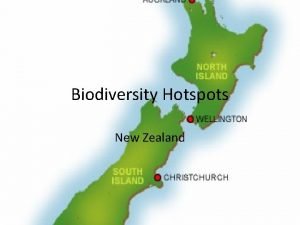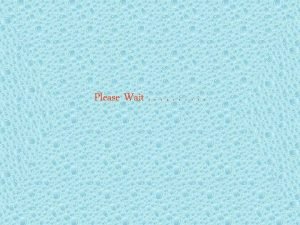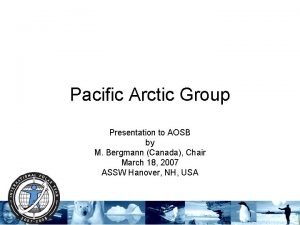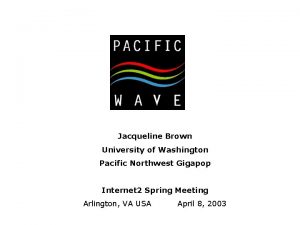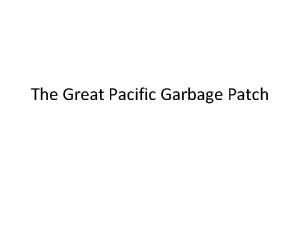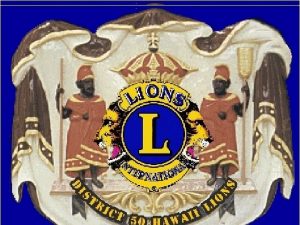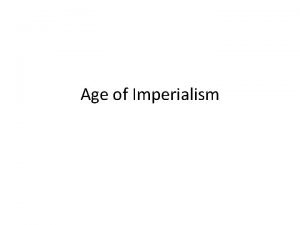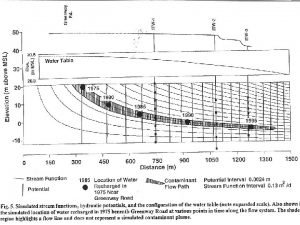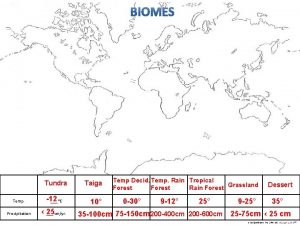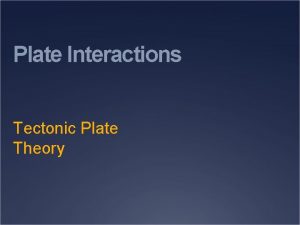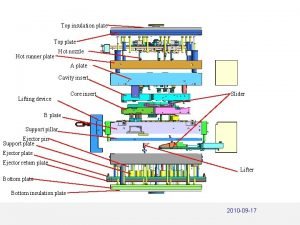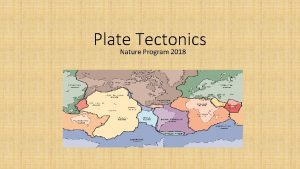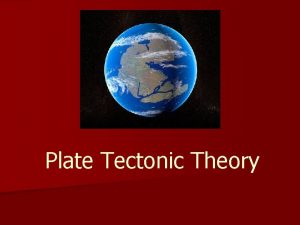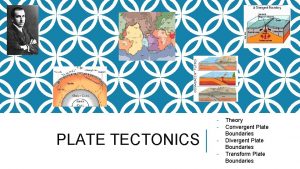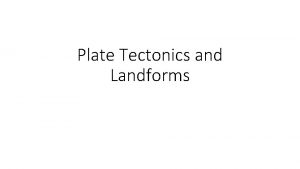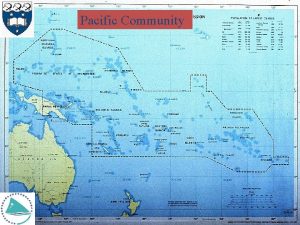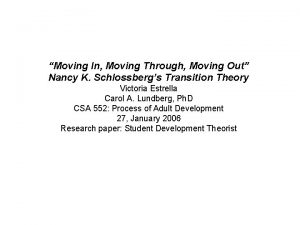Pacific Plate moving over hotspot at 5 cmyr



































- Slides: 35

• Pacific Plate moving over hotspot at 5 cm/yr • Ridge spreading at 6 cm/yr What is direction and rate of motion of Juan de Fuca plate over mantle? • San Andreas slips at 5 cm/yr What is the motion of North American Plate relative to other plates and the hotspot reference frame?


OCEAN/ESS 410 4. Cooling of the Ocean Plates (Lithosphere) William Wilcock

Lecture/Lab Learning Goals • Understand the terms crust, mantle, lithosphere and asthenosphere and be able to explain the difference between oceanic crust and lithosphere • Understand the concepts that govern the relationships that describe the cooling of a halfspace. • Be able to use h≈√κt or equivalently t=h 2/κ • Know heat flow is measured and how it varies with the age of the ocean lithosphere. • Understand the relationship between ocean depth and plate age • Be able to obtain and fit a profile of seafloor bathymetry to a square root of age model - LAB

Oceanic Plates form by Cooling island arc trench fracture zone trench MOR earthquakes Heat Loss ocean crust melt magma 1300°C sediments, cold adiabatically rising crust & mantle material continental crust earthquakes Mantle melt

Chemical & Crust/Mantle versus Lithosphere/Asthenosphere Geophysical Thermal and mechanical structure Composition 100 0°C 1300°C

Terminology Oceanic Crust - Obtained by partial melting of the mantle (~6 km thick) It is a chemical boundary layer Lithosphere - The upper rigid layer that has cooled below ~1000ºC. It is the rigid layer that defines the plate. It thickens with age and approaches 100 km at 100 Mir It is a mechanical boundary layer and a thermal boundary layer. Asthenosphere - The region immediately underlying the lithosphere (from ~100 - 200 km depth) is weak (has a low viscosity). This is because it lies near its melting point.

Temperature. Depth Plot for Mantle Beneath Old Oceanic Plates Lithosphere Asthenosphere Dry Geotherm for Old Ocean Plate dus Soli s lidu t So We The solidus is the temperature at which a rock first starts to melt. The mantle contains a small amount of water (<1%) which lowers the solidus temperature. 1300°C

The Lithosphere Forms by Conductive Cooling

Heat Conduction Fourier’s Law Temperature gradient, K m-1 Heat Flux, W m-2 Negative because heat flows down the temperature gradient Temperature, T Thermal Conductivity, W K-1 m-1 Typical values • Aluminum, 237 W K-1 m-1 • Expanded Polystyrene, 0. 05 W K-1 m-1 • Rocks 1 to 5 W K-1 m-1 Heat Flow Depth, y

Cooling of a column of the lithosphere Because the heat flow is vertical, the cooling of any column of the oceanic lithosphere is the equivalent to the cooling of a half space. The relationship between age, t and horizontal position x is t=x/u where u is the half spreading velocity

Cooling of a Half-space T 0 �T T 0 t = 0+ Tm T 0 Tm t>0 Depth t = 0 - Tm Temperature y, km The math is quite complex but we can gain some insight into the form of the solution from the simple thought experiment that we considered during the last lecture.

How Quickly Do Objects Cool By Heat Conduction? A simple thought Experiment T 1 T 2 Temperature Depth The green object contains twice as much heat energy (because it is twice as thick), but looses heat at only half the rate (because the temperature gradient is halved). It takes four times as long to cool the green object. It takes four times as long to cool to twice the depth.

Approximate Thickness of the Cooled Layer The exact shape of the curves is difficult to derive but we can write an approximate thickness for the cooled region as where κ is thermal diffusivity and has an a value of 10 -6 m 2 s-1 For example at t = 60 Myr (= 60 x 106 x 365 x 86400 s)

Temperature Profiles (Geotherms) at 2 different ages 15 Myr 60 Myr 70 km 35 km

Consequences of Plate Cooling 1. Heat Flow

Heat Conduction Fourier’s Law Temperature gradient, K m-1 Heat Flux, W m-2 Negative because heat flows down the temperature gradient Temperature, T Thermal Conductivity, W K-1 m-1 Typical values • Aluminum, 237 W K-1 m-1 • Expanded Polystyrene, 0. 05 W K-1 m-1 • Rocks 1 to 5 W K-1 m-1 Heat Flow Depth, z

Heat Flow Probe

Heat Flow Measurements Requires Sediments - Difficult near the ridge Average value for the oceans is ~100 m. W m-2 Seafloor Thermistors. Measure temperature gradient Heater. After measuring thermal gradient a pulse of heat is introduced and the rate at which it decays is can be used to estimate thermal conductivity.

1 hfu (heat flow unit) = 42 m. W m-2 Heat Flow Versus Age Mean Value Range of Values Prediction of the half space model Model Exceeds Observations. Hydrothermal cooling Observations exceed model. Plate reaches maximum thickness

Plate Cooling Model The lithosphere has a maximum thickness of ~100 km. Convective instabilities in the asthenosphere prevent it growing any thicker

Consequences of Plate Cooling 2. Seafloor Depth

Seafloor Depth The depth of the seafloor can be calculated using the principal of isostacy - different columns contain the same mass (i. e. , the lithosphere floats). Because warm rocks have a lower density (denoted by the symbol ρ ) than cold ones, the seafloor is shallower above young ocean lithosphere. Cool , ρ = 3400 kg m -3 Hot, ρ = 3300 kg m-3

Seafloor Depth Versus Age The half-space model predicts that the depth increases as the square root of age. This model works out to about 100 Myr at which point depths remain fairly constant (more evidence for the plate model) Half-Space model Misfit suggests Plate model

Age of the Seafloor - Inferred from Magnetic Lineations

Revisiting Lab 2

Relative amount of surface area Age of Terrestrial Planet Surfaces 2/3 of Earth’s surface formed within the last 200 million years Planets form 4 3 2 1 Age of Surface (billions of years)

Earth Plate tectonics replace 2/3 of the surface every ~100 Myr and modifies the remaining 1/3 on geologically short timescales. Evidence at a scale we might see on other planets 1. Linear rifts and arcuate compression zones 2. Transform faults and fracture zones (adjacent transform faults are parallel). 3. Continuous plate boundaries 4. Volcanic Island chains - plates moving over fixed mantle plume (melt source) 5. Topography variations consistent with aging plates.

Global Bathymetry Sandwell and Smith

Mars

Mars • Last eruption on Olympus Mons 2 to ~100 Myr ago • Surface appears to be one plate • Evidence for plate tectonics in the past is controversial • Smaller radius means it cooled down quicker than earth and the lithosphere (the rigid cold layer) is thicker - too strong for plate tectonics • Large volcanoes show surface has not moved relative to mantle plumes

Mantle Convection in Mars model by Walter Kiefer

Venus

VENUS • Burst of volcanism 600 -700 MYrs ago • Either steady state ‘plate tectonics’ stopped then or Venus undergoes episodic bursts of volcanism • Venus has lost its water. • Water in the mantle may be critical for plate tectonics because it weakens the mantle and lubricates the motion of the plates. • In the absence of lubrication the heat from radioactivity may build up inside Venus until it is released in catastrophic mantle overturning events.

Temperature. Depth Plot for Mantle Beneath Old Oceanic Plates Lithosphere Asthenosphere Dry Geotherm for Old Ocean Plate dus Soli s lidu t So We The solidus is the temperature at which a rock first starts to melt. The mantle contains a small amount of water (<1%) which lowers the solidus temperature. 1300°C
 Force exerted by jet on moving plate formula
Force exerted by jet on moving plate formula Streaking method
Streaking method 7 lithospheric plates
7 lithospheric plates Spread plate vs pour plate
Spread plate vs pour plate Convergent boundary oreo
Convergent boundary oreo Pour plate method vs spread plate method
Pour plate method vs spread plate method Hotspot track
Hotspot track Umm hotspot
Umm hotspot Vrrp mikrotik
Vrrp mikrotik Walled garden mikrotik
Walled garden mikrotik Flex security hotspot
Flex security hotspot Telia jobbmobil
Telia jobbmobil Hotspot mikrotik sin login
Hotspot mikrotik sin login Configurar mikrotik hotspot
Configurar mikrotik hotspot The term biodiversity was first coined by *
The term biodiversity was first coined by * Definition of biodiversity hotspot
Definition of biodiversity hotspot Holland circular hotspot
Holland circular hotspot Wallacea hotspot
Wallacea hotspot Biodiversity hotspot in india
Biodiversity hotspot in india The ventures hawaii five-o
The ventures hawaii five-o New zealand biodiversity hotspot
New zealand biodiversity hotspot Krs online umm
Krs online umm Over the mountain over the plains
Over the mountain over the plains Siach reciting the word over and over
Siach reciting the word over and over Taking over navigational watch
Taking over navigational watch Pacific arctic group
Pacific arctic group Pacific rim2 cda
Pacific rim2 cda Methalene
Methalene Pacific northwest gigapop
Pacific northwest gigapop Pacific island forum secretariat
Pacific island forum secretariat East pacific rise
East pacific rise Garbage patch
Garbage patch Pacific lions club
Pacific lions club After 1880 european nations sought
After 1880 european nations sought Pacific carbon trust
Pacific carbon trust Pacific theater timeline
Pacific theater timeline
